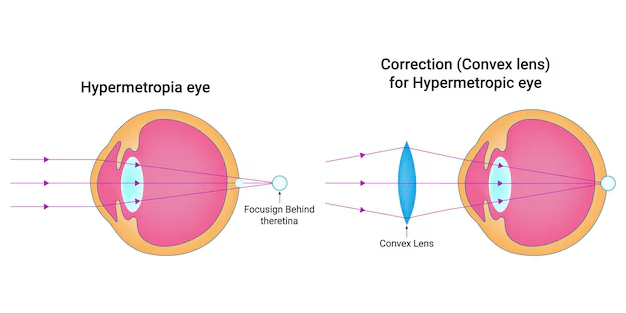Hyperopia (Farsightedness): Your Complete Guide to Understanding and Treating Vision Challenges
Do you find yourself straining to read text messages or struggling with close-up work? Does reading a book give you headaches after just a few minutes? These could be signs of hyperopia, commonly known as farsightedness. As specialists in advanced eye care center services, we're here to provide you with comprehensive information about this common vision condition.
What is Hyperopia?
Hyperopia occurs when your eye focuses images behind rather than precisely on your retina, making nearby objects appear blurry while distant objects remain clear. This refractive error affects millions worldwide, but thanks to modern eye health services and vision correction procedures, there are numerous effective treatment options available.

Key Signs and Symptoms of Hyperopia
Hyperopia, or farsightedness, presents several noticeable symptoms that can affect daily activities. Some of the most common signs include:
Common Indicators
- Difficulty focusing on nearby objects
- Eye strain during close-up tasks
- Frequent headaches, especially after reading
- Squinting to see clearly
- Eye fatigue after detailed work
- Potential blurring of distance vision in severe cases
The Science Behind Farsightedness
Farsightedness, also known as hyperopia, occurs when the eye doesn't refract light correctly, leading to difficulty focusing on nearby objects. Several anatomical factors contribute to this condition, making close-up tasks more challenging and potentially causing discomfort over time.
Anatomical Causes:
- Shorter than normal eyeball length
- Flatter cornea curvature
- Changes in the eye's natural lens
- Age-related vision changes
Risk Factors and Prevention
Hyperopia, or farsightedness, can develop due to various risk factors. Understanding these factors can help in both identifying individuals at risk and implementing preventive measures.
Several factors can contribute to hyperopia development:
Genetic Factors:
- Family history of farsightedness
- Inherited eye structure variations
Environmental and Lifestyle Factors:
- Extended digital device use
- Poor lighting conditions
- Inadequate eye care routine
Age-related changes:
Changes in vision as individuals age can also increase the risk of developing hyperopia.
Advanced Treatment Options at Leading Eye Care Centers
Surgical Interventions
Modern eye treatment hospitals offer various solutions to correct vision issues effectively.
Laser Vision Correction:
- Lasik Eye Surgery: Quick and effective procedure for correcting refractive errors.
- Contoura Vision: Topography-guided precision treatment for enhanced visual outcomes.
- SMILE Laser Surgery: A minimally invasive option with excellent results.
Traditional Surgical Options:
- Refractive Eye Surgery: Customized vision correction tailored to individual needs.
- Corneal Transplant Surgery: Recommended for severe cases where the cornea is damaged.
- Lens Replacement: An advanced surgical solution for those with lens-related issues.
Non-Surgical Solutions
- Prescription eyeglasses for vision correction.
- Contact lenses for a convenient alternative to glasses.
- Vision therapy exercises to improve visual skills.
Why Choose Professional Eye Care Services?
When seeking treatment for hyperopia, it's essential to consult with qualified eye surgery specialists. The best eye hospitals offer:
- Comprehensive eye diagnostics
- State-of-the-art technology
- Experienced ophthalmology diagnostics
- Personalized treatment plans
- Ongoing care and support
Advanced Diagnostic Procedures
Modern eye diagnostics clinics utilize cutting-edge technology to ensure accurate assessments:
- Testing Equipment:
- Digital refraction systems
- Corneal topography
- Wavefront analysis
- Retinal imaging
- Biometry measurements
Treatment Selection Guide
Factors to consider when selecting the appropriate treatment include:
- Severity of hyperopia
- Age and lifestyle
- Overall eye health
- Budget considerations
- Recovery time preferences
Benefits of Early Detection and Treatment
Regular visits to an eye diagnostics clinic are crucial for:
- Preventing vision deterioration
- Identifying related conditions early
- Maintaining optimal eye health
- Ensuring appropriate treatment timing
- Monitoring vision changes
Choosing Your Eye Care Provider
When selecting an advanced eye care center, consider the following key factors:
- Facility reputation and experience
- Available treatment options
- Technology and equipment
- Success rates
- Cost and insurance coverage
- Post-treatment care
Advanced Technology in Hyperopia Treatment
Top-rated refractive eye surgery hospitals employ:
- Latest laser technology
- High-precision surgical instruments
- Advanced imaging systems
- Computer-guided treatment planning
- Real-time eye tracking systems
Recovery and Aftercare for Hyperopia
Post-treatment care includes:
- Regular follow-up appointments
- Medication management
- Activity guidelines
- Vision monitoring
- Long-term care planning
Living with Hyperopia: Practical Tips
Daily management strategies to help with hyperopia:
- Proper lighting for close work
- Regular eye exercises
- Screen time management
- Proper working distances
- Regular eye check-ups
Don't let hyperopia impact your daily life and productivity. With modern treatment options available at the best eye hospitals and affordable Lasik eye surgery clinics, achieving clear vision is possible. Schedule a consultation with our eye health services team to discover your ideal treatment path.
Trust your vision to experienced cornea transplant specialists and eye care experts who understand the importance of precise, personalized care.